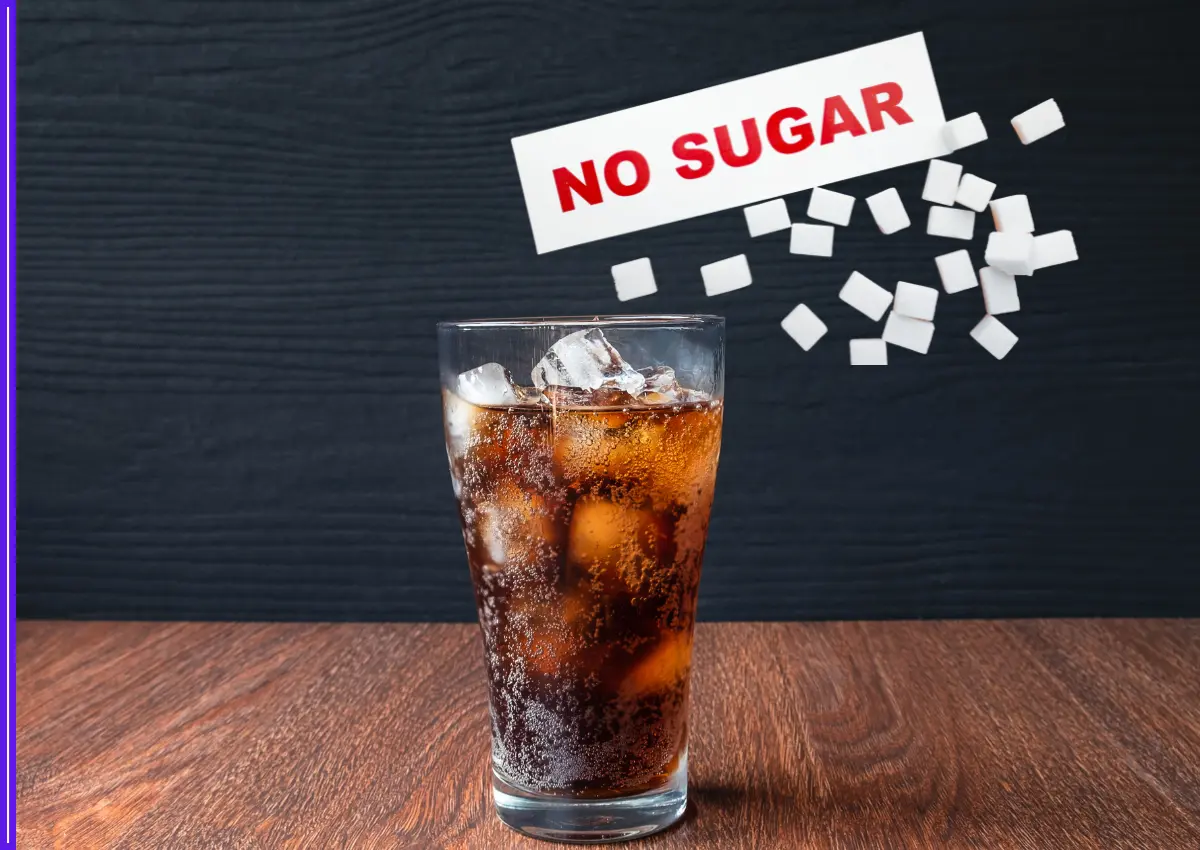How India Fell in Love with Online Grocery Shopping
Before Online Grocery Stores in india, On a quiet Sunday morning in 2015, Neha, a young working professional in Bengaluru, opened her fridge only to find half a bottle of milk, two eggs, and a forgotten tomato wilting in the corner. Normally, this would mean a hurried trip to the local kirana store, but that day she tried something new — she tapped on her phone, selected a few essentials, and placed her first ever online grocery order. Within hours, neatly packed bags arrived at her doorstep. That small moment marked the beginning of a shopping habit that would soon transform how millions of Indians bought their daily food.
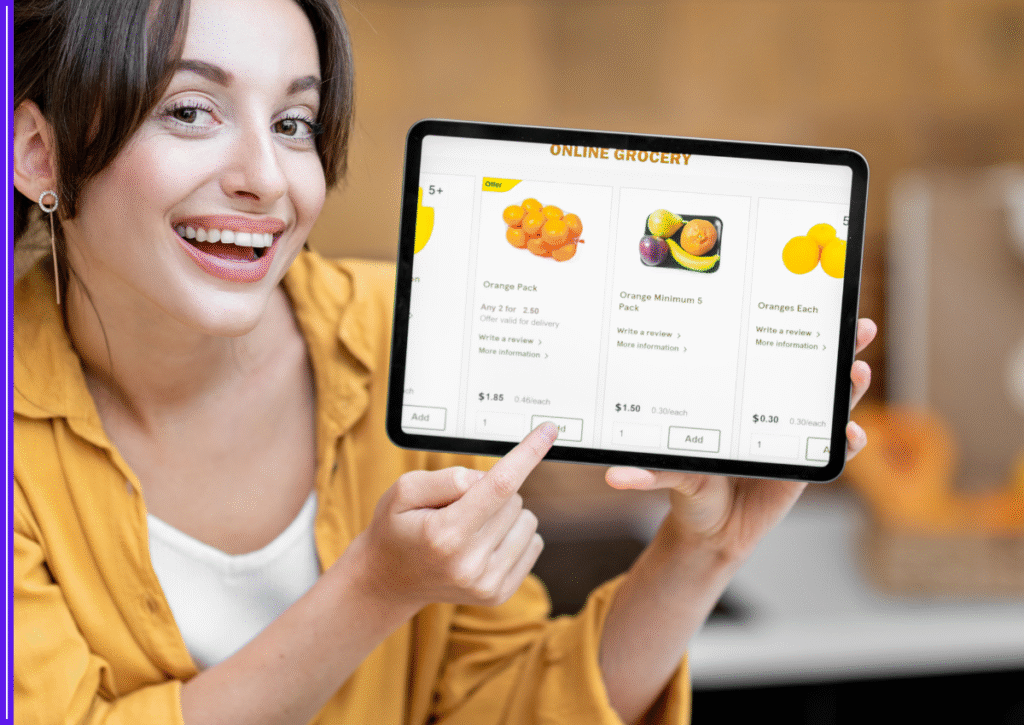
Fast forward to 2025, and India’s online grocery industry is not just a convenience — it’s an essential part of urban and semi-urban life. The once experimental idea has become a market worth billions of dollars, driven by technology, changing lifestyles, and an increasing demand for speed and reliability. Whether it’s a young IT professional in Pune ordering midnight snacks through a 10-minute delivery app, or a homemaker in Jaipur buying organic vegetables for the week, online grocery platforms have found a place in every segment of society.
The Journey from Optional to Inevitable
When online grocery delivery started in the early 2010s, the model struggled with consumer trust. People were used to handpicking fresh vegetables and bargaining over prices. The thought of letting a stranger choose your fruits felt unnatural. But with time, companies invested heavily in supply chain quality, cold storage technology, and customer service. The turning point came during the COVID-19 pandemic in 2020, when online groceries became a lifeline. From that moment, the habit stuck.
In the post-pandemic years, quick commerce entered the scene. Companies promised delivery in 15 minutes, then 10, and in some cases, under 7 minutes. This ultra-fast model captured the imagination of urban India, especially among young professionals and nuclear families. Grocery apps were no longer just about bulk purchases for the week — they became the go-to solution for last-minute needs, impulse cravings, and time-starved customers.
A Market of Giants and Innovators
By 2025, the Indian online grocery space is dominated by a mix of established giants, agile startups, and traditional retail players going digital. Some platforms focus on hyperlocal delivery with dark stores in every neighborhood. Others rely on large warehouses and scheduled slots for bulk orders. Many blend the two models, catering to both instant and planned shopping.
The big players like Blinkit, Zepto, and Swiggy Instamart are engaged in an intense race for speed and market share. Meanwhile, long-standing platforms like BigBasket and Amazon Fresh continue to dominate the planned purchase segment with their wide product range and loyalty programs. Regional heroes are also thriving by offering local produce, ethnic foods, and culturally specific grocery items — proving that personalization is key in India’s diverse market.
Changing Consumer Behavior
The Indian grocery shopper of 2025 is more tech-savvy, more experimental, and far less patient than before. Price remains a factor, but convenience often outweighs small cost differences. Cashless payments, subscription models, and personalized offers have made shopping seamless.
Another major shift is the growing demand for organic, chemical-free, and sustainably sourced products. This has opened up space for niche grocery platforms targeting health-conscious customers. Simultaneously, the integration of AI in grocery apps means your next order might be predicted before you even think of it, with smart suggestions based on your buying history.
The Economic and Social Impact
The rise of online grocery shopping has created thousands of jobs in warehousing, logistics, and last-mile delivery. It has also helped small farmers and local producers connect directly with urban consumers, cutting out middlemen and increasing profit margins for producers. At the same time, competition has pushed companies to innovate in packaging, sustainability, and customer engagement.
As India steps deeper into a digital-first economy, the grocery sector is setting benchmarks for speed, personalization, and customer loyalty. The next phase may not just be about delivering faster — it could be about predicting needs, integrating kitchen appliances with ordering systems, and creating a fully automated shopping experience.
In this article, we’ll take a deep dive into the Top 10 Online Grocery Stores in India in 2025, exploring their journey, business models, customer experiences, and what makes them leaders in this competitive landscape. From billion-dollar unicorns to specialized regional champions, these platforms are redefining how India shops for its most essential goods.
1. Blinkit – The Speed Icon of Indian Grocery
Blinkit, formerly known as Grofers, has emerged as the quintessential symbol of ultra-fast grocery delivery in India. What began as a simple online grocery platform in 2013 underwent a dramatic transformation in 2021 when the company rebranded to Blinkit, signalling a new era: groceries delivered in 10 minutes or less.
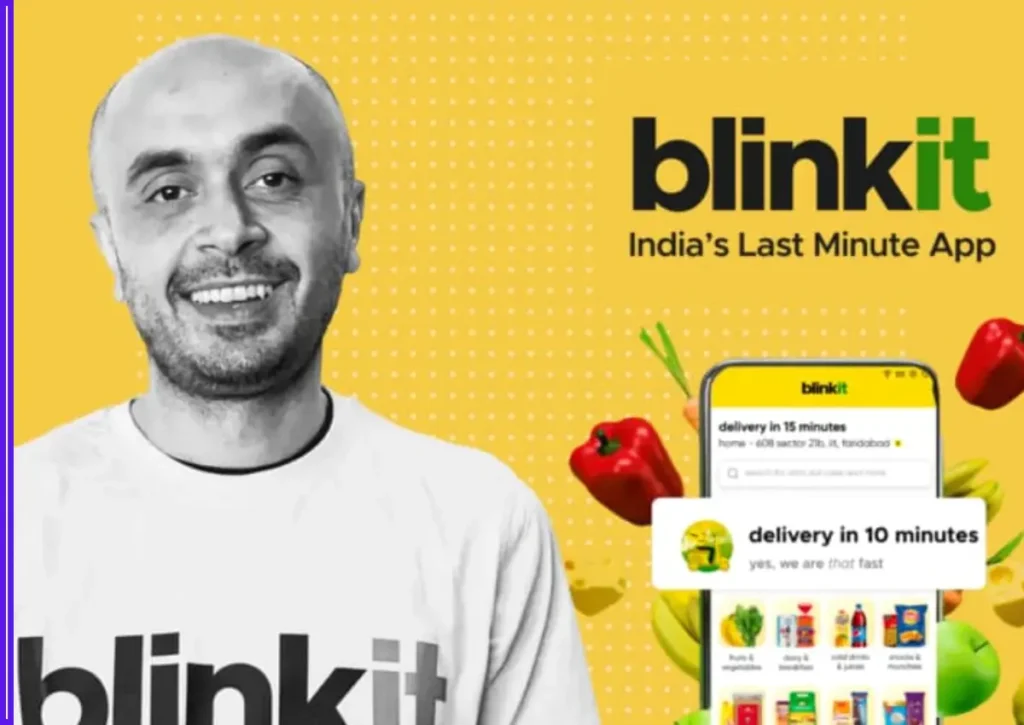
The Story Behind Blinkit
The founders realised that the modern Indian shopper wanted speed, convenience, and reliability. In a country where traffic jams and long queues could make a quick grocery run a stressful task, Blinkit identified an opportunity to serve time-conscious urban professionals and families. The pivot to “quick commerce” was not just a marketing move; it involved a complete overhaul of logistics, inventory management, and user experience.
What Sets Blinkit Apart
- Hyperlocal Warehousing: Blinkit relies on strategically placed “dark stores” — mini-warehouses stocked with high-demand items — allowing delivery partners to reach customers within minutes.
- Curated Inventory: To ensure speed and accuracy, Blinkit limits its offerings to essential groceries, snacks, beverages, and household items that sell fast. This selective inventory enables rapid picking and packing.
- Technology-Driven Operations: Advanced AI predicts demand patterns and optimises stock levels in each dark store, reducing wastage and ensuring that popular products are always available.
- Urban Reach: Blinkit operates in over 30 major cities, with plans to expand further, focusing on metros and tier-1 cities where the demand for speed is highest.
Customer Experience
Blinkit’s success is rooted in user trust and convenience. Customers value reliability — the app not only guarantees delivery speed but also ensures that products arrive fresh and intact. Notifications, real-time tracking, and instant refunds for missing or damaged items enhance the customer experience.
Customer Story: Rahul, a young father in Gurugram, shares his experience: “One night, my baby ran out of diapers. I placed an order on Blinkit, and within 12 minutes, the delivery was at my doorstep. It’s become indispensable for urgent needs.”
Strategic Growth
Blinkit has attracted significant investment to fuel its rapid expansion. Partnerships with local suppliers, bulk brands, and e-payment platforms have strengthened its position in the quick commerce market. Despite the operational costs of maintaining dark stores and high-speed delivery, Blinkit’s focus on efficiency and scale has kept it profitable in targeted markets.
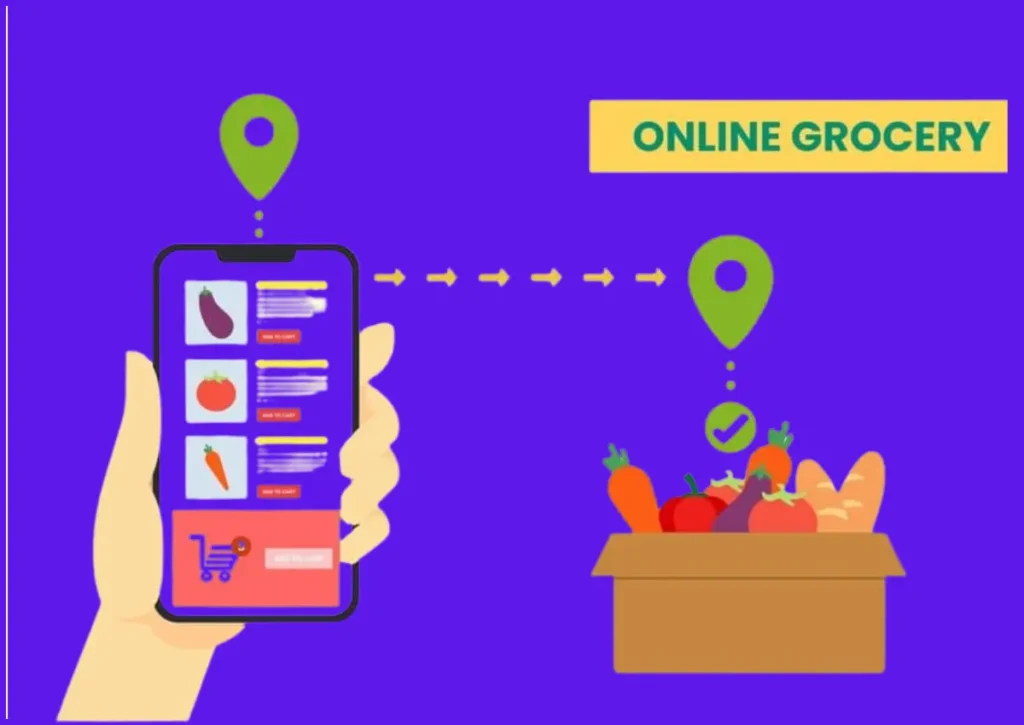
The Future of Blinkit
By 2025, Blinkit is not just about speed; it is about creating a reliable urban ecosystem where customers can order groceries, snacks, and essential items with confidence. The company’s vision extends beyond metros to include tier-2 cities, demonstrating that quick commerce is not just a luxury but a growing expectation across India.
Summary: Blinkit exemplifies the power of speed, technology, and customer trust in shaping the modern Indian grocery market. Its model has inspired competitors and raised the bar for the industry, making it a key player in the race to redefine how India shops for daily essentials.
2. Swiggy Instamart – Food Delivery Meets Grocery
Swiggy, already a household name in India for restaurant food delivery, spotted a natural opportunity in the grocery sector. If they could deliver a piping-hot biryani in 30 minutes, why not deliver bread, milk, and eggs with similar speed and reliability? That insight led to the launch of Swiggy Instamart, a platform designed to bring groceries to doorsteps in under 30 minutes.
The Story Behind Instamart
Launched in 2020 as an experimental service, Instamart quickly became a core part of Swiggy’s strategy. Leveraging Swiggy’s existing network of delivery personnel and logistics expertise, the platform initially focused on essential items in select metro areas. The response was overwhelming, particularly from urban professionals and young families who valued convenience, speed, and reliability. By 2025, Swiggy Instamart has scaled to over 750 dark stores across 25 cities, with plans to expand to more tier-2 locations.
What Sets Swiggy Instamart Apart
- Integration with Swiggy Ecosystem: Customers already using Swiggy for food delivery can seamlessly switch to Instamart, making grocery shopping effortless.
- Optimized Dark Stores: Similar to other quick commerce platforms, Instamart uses local micro-warehouses stocked with high-demand essentials, ensuring rapid delivery.
- Subscription Benefits: Swiggy One members enjoy free delivery and special discounts, encouraging repeat orders and loyalty.
- Curated Inventory: Focused on daily essentials, snacks, beverages, and household goods, Instamart prioritizes items that customers need urgently, ensuring they never run out.
Customer Experience
Instamart has built a reputation for reliability and transparency. Real-time order tracking, timely notifications, and hassle-free refunds have enhanced customer trust. Swiggy’s established delivery culture ensures items arrive in good condition, and the platform often exceeds expectations with same-hour delivery in urban hotspots.
Customer Story: Ananya, a software engineer in Mumbai, shares, “When I realized we had no vegetables for dinner, I ordered from Instamart. Within 20 minutes, everything I needed was at my doorstep. It’s like having a mini grocery store in my neighborhood.”
Strategic Growth
Swiggy Instamart’s rapid expansion is backed by significant funding and strategic partnerships with brands and local suppliers. By combining insights from the food delivery side with grocery demand, the platform has optimized supply chains and minimized delivery delays. Additionally, Instamart experiments with predictive stocking, ensuring popular items are always available in neighborhoods where they’re most needed.
The Future of Instamart
As of 2025, Instamart is not just competing in the quick commerce space — it is setting standards for integrated delivery services, combining food, groceries, and household essentials under one platform. Swiggy aims to expand into smaller cities while maintaining the quality and speed that urban customers have come to expect.
Summary: Swiggy Instamart showcases how existing logistics expertise, integration, and customer-centric operations can revolutionize grocery delivery, making it an indispensable part of India’s modern shopping ecosystem.
3. Zepto – The Gen Z Quick Commerce Powerhouse
In the rapidly evolving landscape of Indian online grocery, Zepto has emerged as a formidable challenger. Founded in 2021 by two young entrepreneurs, Zepto has achieved meteoric growth, becoming one of India’s most valuable quick commerce startups with a valuation exceeding $5 billion by 2025. The platform has redefined expectations for ultra-fast grocery delivery, catering to urban millennials and Gen Z consumers who prioritize speed, convenience, and technology-driven experiences.
The Story Behind Zepto
Zepto was born out of a simple observation: urban shoppers were increasingly frustrated with traditional grocery delivery timelines. The founders envisioned a platform capable of delivering essential groceries in 10 minutes or less, a promise that was once thought impossible in India’s congested urban environment. Through strategic use of technology, dark stores, and a highly efficient logistics network, Zepto turned this vision into reality, creating a brand that resonates strongly with India’s young, tech-savvy population.
What Sets Zepto Apart
- Hyperlocal Dark Stores: Zepto operates hundreds of small warehouses in key neighborhoods to ensure near-instant deliveries, minimizing travel time and inventory errors.
- AI-Driven Inventory Management: The platform leverages artificial intelligence to predict demand at the micro-level, optimizing stock placement and reducing wastage.
- User-Centric App Design: Zepto’s mobile app emphasizes simplicity, speed, and personalization, with intuitive navigation and quick reordering options based on past purchases.
- Youth-Oriented Marketing: The brand’s campaigns are heavily social media-focused, incorporating pop culture, memes, and influencer collaborations to engage younger audiences.
Customer Experience
Zepto’s value proposition extends beyond speed. Customers appreciate the reliability, product quality, and the curated selection of essentials, snacks, beverages, and household goods. Real-time order tracking, transparent pricing, and responsive customer support further enhance user satisfaction.
Customer Story: Neha, a 24-year-old professional in Mumbai, says, “I often need last-minute ingredients for cooking. Zepto delivers them in under 12 minutes. It’s become my go-to app for urgent grocery needs, and I honestly don’t know how I managed without it.”
Strategic Growth
Zepto has secured significant funding to fuel its expansion, targeting 700 dark stores by early 2025. Partnerships with local suppliers, bulk brands, and fintech solutions have strengthened its operational backbone. The company is also exploring AI-powered recommendations and predictive stocking to anticipate customer needs even before they place an order.
The Future of Zepto
By 2025, Zepto is no longer just a quick commerce startup; it is a trendsetter in urban grocery delivery. With plans to expand into tier-2 cities while maintaining speed and efficiency in metros, Zepto continues to raise the bar for its competitors. Its focus on technology, customer experience, and rapid delivery positions it as a dominant force shaping the future of India’s grocery market.
Summary: Zepto exemplifies the power of technology-driven operations, rapid delivery, and youth-focused branding. Its innovative approach has set new benchmarks in quick commerce, inspiring competitors and reshaping consumer expectations across urban India.
4. JioMart – The Kirana Connector
Reliance Retail’s JioMart is a unique force in India’s online grocery market. Launched in 2019, it bridges the gap between traditional kirana stores and modern e-commerce. Instead of trying to replace local retailers, JioMart integrates them into its digital ecosystem, creating a win-win for both consumers and small business owners.
The Story Behind JioMart
India is home to over 12 million kirana stores, many of which are family-owned. Reliance Retail identified that while e-commerce was growing in metros, these stores still dominated smaller towns and neighborhoods. JioMart’s strategy was simple yet revolutionary: digitize kirana stores, enabling them to fulfill online orders while retaining their customer base. By 2025, JioMart serves millions of households across tier-1, tier-2, and tier-3 cities, making it one of the widest-reaching grocery platforms in India.
What Sets JioMart Apart
- WhatsApp Ordering: Customers can browse products, place orders, and track deliveries directly through WhatsApp, making it intuitive even for less tech-savvy users.
- Hyperlocal Fulfillment: By partnering with neighborhood stores, JioMart ensures faster deliveries while supporting local economies.
- Competitive Pricing: Leveraging Reliance’s scale, the platform offers discounts and promotions that rival traditional e-commerce players.
- Variety and Customization: From fresh produce to packaged goods and daily essentials, JioMart caters to diverse customer needs, including regional products and culturally specific groceries.
Customer Experience
JioMart excels at accessibility and convenience. Customers appreciate the combination of digital ease and local trust. For example, users in smaller towns can order fresh vegetables without worrying about unfamiliar quality, thanks to the longstanding reputation of their local kirana partner. Real-time updates, multiple payment options, and easy returns further enhance satisfaction.
Customer Story: Ramesh, a resident of Jaipur, shares, “I never thought online grocery could work in my neighborhood. JioMart connects me to the same trusted store I’ve shopped at for years, but now I can order from home, and they deliver in a few hours.”
Strategic Growth
JioMart’s growth strategy focuses on deepening kirana partnerships and expanding into semi-urban and rural markets. Integration with Reliance Jio’s mobile ecosystem provides a seamless interface for ordering, payments, and promotions. By digitizing millions of small retailers, JioMart is creating a distributed logistics network that is both scalable and cost-effective.
The Future of JioMart
By 2025, JioMart is not only a grocery platform but also a digital transformation engine for local retailers. Its ability to combine hyperlocal reach, competitive pricing, and technology integration positions it as a formidable player, particularly in regions where traditional e-commerce struggles to penetrate.
Summary: JioMart is a bridge between tradition and modernity, combining the convenience of online ordering with the trust and reach of India’s kirana stores. Its model is a blueprint for inclusive, technology-driven growth in the grocery sector.
5. Amazon Pantry & Amazon Fresh – The E-Commerce Titan
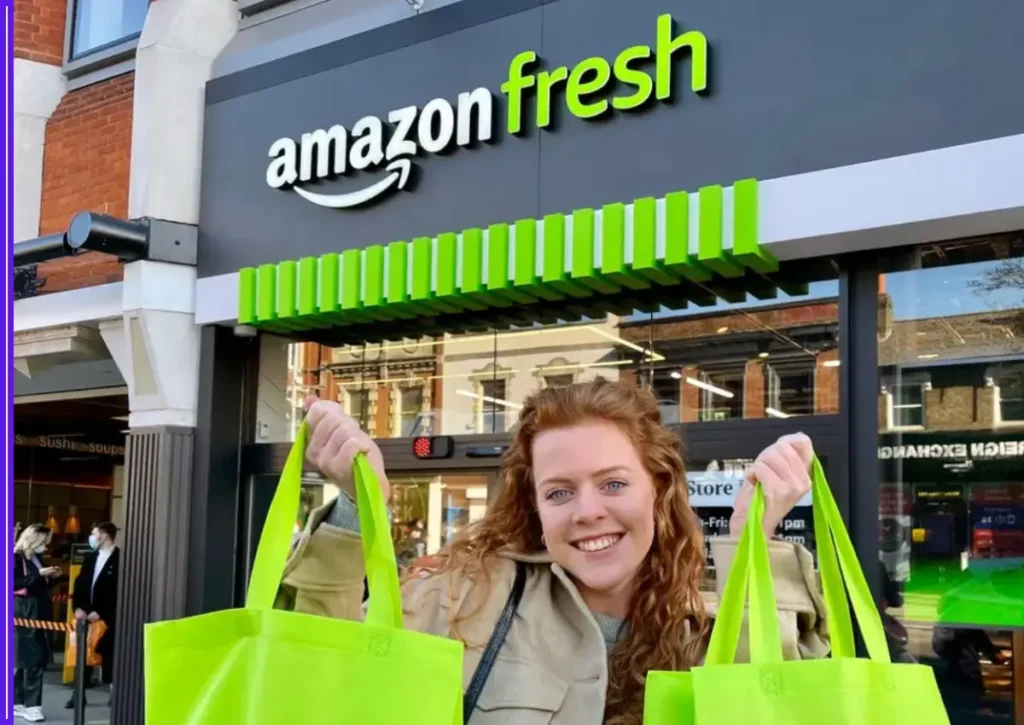
Amazon India’s grocery offerings, split into Amazon Pantry for bulk and planned purchases and Amazon Fresh for same-day or next-day delivery, exemplify the scale and efficiency of a global e-commerce leader adapting to Indian needs.
The Story Behind Amazon Grocery
Amazon entered the Indian grocery market in the mid-2010s, leveraging its global expertise in logistics, supply chain, and technology. While initial adoption was slow due to consumer hesitation, the platform steadily built trust through timely delivery, reliable packaging, and customer-centric policies.
What Sets Amazon Apart
- Prime Integration: Prime members enjoy faster delivery, discounts, and curated deals, making repeat purchases seamless.
- Wide Product Range: From staples like rice, lentils, and cooking oil to imported cheeses, wines, and organic products, Amazon offers unparalleled variety.
- Flexible Delivery Options: Customers can choose one-hour, same-day, or next-day delivery, depending on urgency and location.
- Predictive Stocking & Recommendations: AI algorithms suggest products based on purchase history and seasonal trends, improving convenience.
Customer Experience
Amazon’s reliability is a key factor. Users trust that fresh items will arrive on time and packaged well. Its customer support, return policies, and digital payment integration make it easy to shop across categories.
Customer Story: Sanya, living in Bengaluru, says, “I order rice, pasta, and sometimes imported snacks. The convenience of having it all delivered without leaving home saves me hours every month. Amazon Fresh is like a virtual supermarket in my pocket.”
Strategic Growth
Amazon continues to invest heavily in India’s grocery sector, expanding warehouses, cold storage facilities, and partnerships with local suppliers. Its goal is to dominate both urban and semi-urban markets while maintaining a premium service experience.
The Future of Amazon Grocery
Amazon aims to integrate more technology, including drone deliveries, smarter AI recommendations, and even subscription models for recurring orders. Its brand strength and logistical prowess ensure it remains a top choice for Indian consumers.
Summary: Amazon Pantry and Fresh leverage scale, technology, and trust, offering both variety and reliability, making it a strong contender in India’s competitive online grocery space.
6. Nature’s Basket – The Gourmet Experience
Nature’s Basket has carved a niche in India’s online grocery space by focusing on premium and gourmet products. Established in 2003, the brand originally operated offline in metros, offering international delicacies and high-quality fresh produce. Its online expansion allowed it to reach a broader audience without compromising the boutique-style shopping experience.
The Story Behind Nature’s Basket
As India’s urban population developed a taste for imported foods and specialty ingredients, Nature’s Basket identified a gap in the market. While mainstream grocery platforms focused on essentials, Nature’s Basket curated products like Italian cheeses, French pastries, organic oils, exotic fruits, and specialty beverages. By digitizing its catalog, it offered a luxury grocery shopping experience at home, appealing to food enthusiasts and health-conscious urban dwellers.
What Sets Nature’s Basket Apart
- Premium Product Selection: Every item is handpicked for quality, freshness, and authenticity.
- Curated Categories: From artisanal cheeses to organic pantry staples, the platform ensures customers discover unique products not available elsewhere.
- Online-Offline Integration: Customers can order online or visit stores for tasting and personalized advice.
- Gifting and Seasonal Specials: The platform offers curated gift hampers, festive baskets, and limited-edition items, enhancing its luxury appeal.
Customer Experience
Nature’s Basket focuses on customer delight through premium packaging, timely delivery, and quality assurance. Orders often include tips on storage and usage, adding a personal touch.
Customer Story: Rohit, a software engineer in Mumbai, shares, “I love cooking international recipes, and Nature’s Basket is my go-to for ingredients I can’t find elsewhere. The products always arrive fresh, and the experience feels luxurious.”
Strategic Growth
Nature’s Basket has expanded its online reach to cover major metros like Mumbai, Delhi, Bengaluru, and Hyderabad. Collaborations with local suppliers for fresh organic produce and imports for gourmet items strengthen its supply chain. Its parent company, Reliance Retail, provides financial and technological support for scaling operations and integrating loyalty programs.
The Future of Nature’s Basket
By 2025, Nature’s Basket plans to expand premium grocery offerings in tier-2 cities and enhance subscription models for curated weekly baskets. With increasing health awareness and a growing urban foodie culture, the platform aims to lead India’s premium grocery segment.
Summary: Nature’s Basket combines luxury, curation, and convenience, appealing to consumers who value quality and exclusive products, setting it apart in a competitive online grocery market.
7. Country Delight – Freshness Delivered
Country Delight focuses on farm-to-door delivery, emphasizing fresh, unadulterated milk and dairy products. Founded in 2015, it has expanded its offerings to include eggs, bread, fruits, and vegetables, all sourced directly from local farms.
The Story Behind Country Delight
Country Delight’s mission is to ensure that fresh, natural products reach urban consumers without chemical preservatives or middlemen. Its subscription-based model guarantees daily delivery, often arriving before breakfast, making it a trusted service for families.
What Sets Country Delight Apart
- Farm-to-Consumer Model: Direct sourcing from farms ensures traceability and freshness.
- Subscription Convenience: Daily essentials are delivered automatically, reducing last-minute shopping trips.
- Focus on Health: Products are chemical-free, organic where possible, and packaged to retain natural goodness.
- Wide Geographic Reach: By 2025, Country Delight operates in over 20 cities, with plans for nationwide expansion.
Customer Experience
Families appreciate the reliability and quality. Regular updates, clear packaging, and consistent delivery times build loyalty.
Customer Story: Kavita, a mother in Pune, says, “I trust Country Delight for my children’s milk and eggs. The freshness is unmatched, and I don’t worry about preservatives or additives.”
Strategic Growth
Country Delight invests in cold storage, logistics optimization, and farmer partnerships. Expansion into grocery essentials beyond dairy strengthens customer retention and increases average order value.
The Future of Country Delight
By 2025, Country Delight aims to expand its delivery network and introduce healthy ready-to-eat options, leveraging its reputation for quality and freshness.
Summary: Country Delight has positioned itself as India’s trusted health-first grocery platform, combining farm-fresh products with convenient delivery.
8. DMart Ready – The Budget Champion
DMart Ready is the digital extension of the popular DMart retail chain, focusing on value-conscious online shoppers. It combines DMart’s low-price philosophy with the convenience of home delivery.
The Story Behind DMart Ready
As more customers moved online, DMart launched its e-commerce arm to ensure that budget-friendly groceries were accessible digitally. Its platform caters to families seeking savings without compromising on product variety or quality.
What Sets DMart Ready Apart
- Competitive Pricing: Leveraging DMart’s bulk procurement and cost efficiencies.
- Wide Product Range: Staples, household goods, personal care items, and beverages.
- Flexible Delivery Options: Customers can choose home delivery or store pickup.
- Urban and Semi-Urban Reach: Expanding into tier-2 cities to reach more budget-conscious shoppers.
Customer Experience
Customers appreciate the affordable prices and reliable delivery, especially for bulk orders. While not as fast as quick commerce apps, DMart Ready focuses on planned shopping and savings.
Customer Story: Suresh, a father in Ahmedabad, says, “I order my monthly groceries from DMart Ready. The prices are unbeatable, and I get everything delivered without leaving home. It’s perfect for budgeting families.”
Strategic Growth
DMart Ready continues to expand its online presence, integrating inventory management systems for efficiency and adding special promotions and bulk deals to attract regular shoppers.
The Future of DMart Ready
By 2025, DMart Ready aims to strengthen delivery infrastructure and enhance user experience, ensuring it remains the preferred choice for value-conscious consumers.
Summary: DMart Ready represents affordable, reliable, and convenient grocery shopping, appealing to families who prioritize savings and bulk purchases.
9. Spencer’s Online – The Legacy Retailer
Spencer’s Online combines decades of retail experience with a growing e-commerce platform, providing groceries, personal care, and household essentials.
The Story Behind Spencer’s Online
Spencer’s, established in 1863 as a British-era retail chain, adapted to modern consumers by launching its online grocery platform. Its strength lies in trust built over generations and a strong network of physical stores to support fulfillment.
What Sets Spencer’s Online Apart
- Physical-Online Integration: Uses existing stores to fulfill online orders quickly.
- Wide Product Range: Fresh produce, packaged groceries, personal care, and household items.
- Urban Reach: Focused on metros and tier-2 cities with high brand recognition.
- Reliable Service: Consistent delivery, customer support, and return policies enhance trust.
Customer Experience
Shoppers value the familiarity and reliability of Spencer’s. The online platform mirrors in-store shopping with curated categories and promotions.
Customer Story: Meera, a resident of Kolkata, shares, “I’ve shopped at Spencer’s for years. The online platform makes it convenient to get essentials without going out, and I trust the quality as much as in-store purchases.”
Strategic Growth
Spencer’s invests in technology, online catalogs, and delivery partnerships. Expansion focuses on bridging urban and semi-urban areas with reliable service.
The Future of Spencer’s Online
By 2025, Spencer’s aims to enhance digital experiences, introduce subscription models, and further integrate offline stores with online operations.
Summary: Spencer’s Online combines legacy, trust, and modern convenience, appealing to long-standing customers and new online shoppers alike.
10. FreshtoHome – The Fresh Food Specialist
FreshtoHome is a niche online grocery platform specializing in fresh meat, seafood, and ready-to-cook items, catering to consumers who prioritize freshness and quality. Founded in 2015, the brand has expanded into a broader grocery platform while maintaining its core promise: delivering farm- and sea-fresh products to urban households.
The Story Behind FreshtoHome
In India, access to fresh seafood and high-quality meat has often been a challenge due to supply chain limitations. FreshtoHome addressed this gap by creating a cold chain-based delivery network, sourcing directly from fisheries and farms, and delivering to homes within hours. Over time, the platform diversified into fresh vegetables, dairy, and grocery essentials, creating a comprehensive fresh food ecosystem.
What Sets FreshtoHome Apart
- Cold Chain Logistics: Maintains freshness from source to doorstep using temperature-controlled packaging and transport.
- Direct Sourcing: Partners with farmers and fishermen to reduce intermediaries, ensuring quality and fair pricing.
- Quick and Reliable Delivery: Focused on urban centers with 2–6 hour delivery windows for perishable items.
- Health and Hygiene Standards: Strict quality checks, chemical-free produce, and hygienic packaging build customer trust.
Customer Experience
FreshtoHome appeals to health-conscious urban families who want farm- and sea-fresh items without compromise. The platform also provides recipes, cooking tips, and portion guidance, enhancing user experience.
Customer Story: Priya, living in Chennai, says, “I rely on FreshtoHome for fish and chicken deliveries. The freshness is unmatched, and it saves me trips to the market. Their vegetable and dairy range is an added bonus.”
Strategic Growth
FreshtoHome has expanded into multiple metros and is working on tier-2 city expansion. Investments in cold storage hubs and predictive inventory management enable scalability while maintaining product quality.
The Future of FreshtoHome
By 2025, FreshtoHome aims to strengthen its fresh grocery vertical, introduce subscription-based weekly deliveries, and integrate AI to predict customer demand for perishable items.
Summary: FreshtoHome exemplifies the growing demand for fresh, high-quality, and hygienically delivered groceries, carving a niche in India’s competitive online grocery sector.
Market Trends in India’s Online Grocery Sector (2025)
By 2025, India’s online grocery market has transformed significantly. Key trends include:
- Quick Commerce Dominance: Platforms like Blinkit, Zepto, and Instamart have made 10–15 minute deliveries a reality, particularly in metros.
- Integration with Kirana Stores: JioMart and similar platforms digitize local stores, creating efficient hyperlocal supply chains.
- Subscription Models: Daily essentials, dairy, and fresh produce subscriptions increase customer retention.
- Premiumization: Platforms like Nature’s Basket cater to urban consumers seeking gourmet, organic, and international products.
- Tech-Driven Operations: AI and predictive analytics optimize inventory, reduce wastage, and personalize customer recommendations.
- Rising Health Awareness: Demand for organic, chemical-free, and farm-fresh products is growing rapidly.
- Sustainability Focus: Companies are exploring eco-friendly packaging and reducing carbon footprints.
FAQs About Online Grocery in India (2025)
Q1: Which online grocery platform delivers fastest in India?
Blinkit, Zepto, and Swiggy Instamart specialize in ultra-fast delivery, often within 10–15 minutes in metro cities.
Q2: Can I order groceries in tier-2 or tier-3 cities?
Yes. JioMart, DMart Ready, and Country Delight have expanded into smaller towns, offering deliveries to a wider audience.
Q3: Are fresh fruits and vegetables reliable online?
Yes, platforms like BigBasket, Nature’s Basket, and FreshtoHome focus on quality control and direct sourcing for freshness.
Q4: Are subscription models cost-effective?
Yes. Subscriptions for dairy, milk, and daily essentials often save time and money while ensuring regular supply.
Q5: Can I trust quick commerce apps for hygiene?
Reputable platforms maintain strict quality checks, temperature-controlled packaging, and delivery hygiene standards.
Q6: How do online grocery prices compare to physical stores?
Pricing is often competitive, with platforms like DMart Ready offering significant savings, while premium platforms may charge more for curated or imported goods.
Q7: Are there eco-friendly options?
Which is the best online grocery store in India?
The best store depends on your needs. BigBasket and Amazon Pantry are great for variety and nationwide delivery, while StarQuik is excellent for quick deliveries.
Is online grocery shopping cheaper than offline shopping?
Many online stores offer discounts, promo codes, and deals, often making them more affordable than physical stores. However, prices vary by location and platform.
Which online grocery store offers the fastest delivery?
StarQuik offers a three-hour delivery guarantee in select areas. Blinkit (formerly Grofers) is also known for rapid delivery in certain cities.
Are fresh fruits and vegetables available online?
Yes, most online grocery platforms, including BigBasket, Nature’s Basket, and Reliance Smart, offer fresh produce delivered to your doorstep.
Can I return groceries bought online?
Return policies vary by platform, but most allow returns or replacements for damaged or expired items. It’s best to check the store’s policy before ordering.
Do these stores deliver in small towns?
While some platforms focus on metro cities, others like Amazon Pantry, Reliance Smart, and Patanjali Ayurved cover smaller towns and rural areas.
Is membership worth it for online grocery shopping?
If you shop frequently, membership options like Easyday Club can provide significant savings and added benefits.
Many platforms now use recyclable packaging, biodegradable bags, and sustainable logistics practices.
Conclusion: The Future of Online Grocery in India
The online grocery sector in India in 2025 is a dynamic mix of speed, technology, and diversity. From lightning-fast platforms like Blinkit and Zepto to premium curators like Nature’s Basket and health-first providers like Country Delight, there is a service tailored for every need.
By 2030, we can expect:
- Wider adoption in tier-2 and tier-3 cities
- More AI-driven personalized recommendations
- Greater integration of quick commerce with traditional supply chains
- Expansion of subscription and ready-to-cook services
Ultimately, India’s grocery market is moving faster, fresher, and smarter, reflecting the country’s evolving lifestyles and technological progress.







